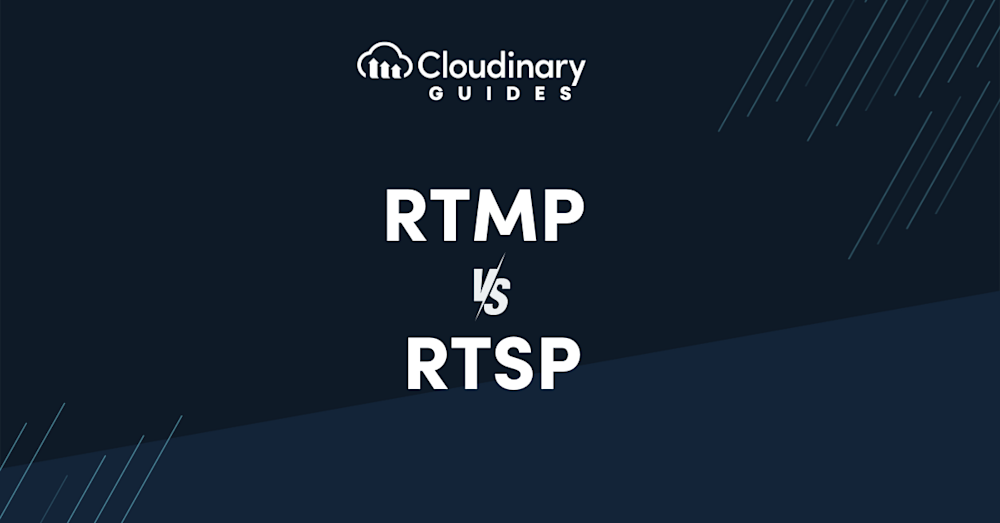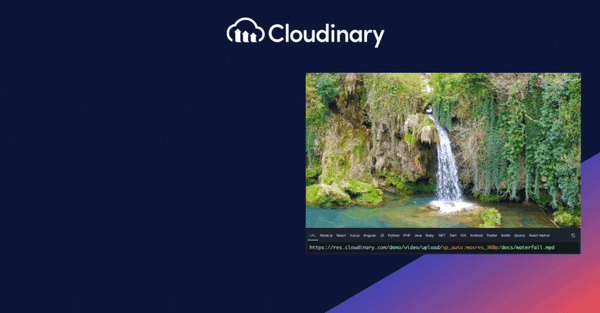
RTMP (Real-Time Messaging Protocol) and RTSP (Real-Time Streaming Protocol) are two cornerstone technologies that enable live streaming and broadcasting. While RTMP is renowned for its high compatibility with flash players and low-latency streaming, making it a go-to for live broadcasts, RTSP offers unparalleled control over streaming sessions, with capabilities like pause, play, and record, ideal for surveillance and conferencing.
Despite the gradual shift towards newer protocols, RTMP and RTSP continue to be widely utilized, with industry reports highlighting their enduring relevance in the streaming landscape. This article aims to dissect the differences between RTMP and RTSP, providing a comprehensive understanding of their benefits and applications across the web.
In this article:
What is RTMP?
RTMP, or Real-Time Messaging Protocol, was originally developed by Macromedia to stream audio, video, and data over the internet. After Adobe acquired Macromedia, RTMP became a cornerstone of the Adobe Flash ecosystem, where it was widely adopted for video-on-demand and live streaming.
Although Flash is no longer supported, RTMP remains a popular protocol thanks to its low latency, high reliability, and stable connections. Operating over TCP, it sends data in smaller, ordered segments, ensuring smooth delivery between media servers and players.
RTMP is particularly well-suited for real-time applications such as live broadcasts, gaming streams, and interactive experiences. Its ability to maintain a constant connection makes it a standard for transmitting multimedia data, and many platforms, including YouTube and Facebook, continue to rely on RTMP for dependable, low-latency streaming.
Understanding How RTMP Works for Streaming
The RTMP streaming workflow is built around three key components: an encoder, a streaming server, and a media player. The encoder captures the audio and video content, converts it into a streamable format, and then sends this data to the streaming server.
The streaming server acts as the hub, managing and distributing the stream to viewers. When a user attempts to watch a live stream or video on demand, their media player sends a request to the server. Using the RTMP protocol, the server establishes a direct connection with the player and delivers the encoded multimedia stream, which the player then decodes for smooth playback.
Pros of RTMP
- Low Latency – RTMP excels at delivering content with minimal delay. This is essential for live events, where even a slight lag can detract from the viewer’s experience.
- High Compatibility – Even with the death of Flash, RTMP is supported by a wide range of streaming servers and platforms. This makes it a versatile choice for developers looking to reach a broad audience.
- Adaptive Bitrate Streaming – RTMP supports dynamic video quality adjustment based on the viewer’s bandwidth, ensuring a smooth viewing experience even under fluctuating internet conditions.
- Interactive Features – RTMP enables elements such as live chat, viewer polls, and simulcasting. These tools boost audience engagement and help create a more connected, community-driven live streaming experience.
Cons of RTMP
- Declining Browser Support – With the phasing out of Flash, RTMP isn’t as relevant to many web browsers for support. Modern implementations often require a media server to convert RTMP streams into a more compatible format like HLS or DASH for web playback.
- Resource-Intensive – Maintaining a continuous connection for RTMP streams can be more resource-intensive for servers than HTTP-based streaming protocols. This might increase the cost and complexity of infrastructure, especially for large-scale broadcasts.
- HTML5 Incompatibility – Since RTMP depends on Flash players, which are now obsolete, it cannot play directly in HTML5 players without conversion. This adds extra steps to integration and playback.
- Bandwidth Limitations – RTMP streams may struggle with low bandwidth, often causing interruptions and reducing overall viewing quality.

What is RTSP?
RTSP, or Real-Time Streaming Protocol, is a network control protocol designed to manage streaming media servers in entertainment and communication systems. Its primary function is to establish and control media sessions between endpoints, enabling clients to issue familiar VCR-style commands such as play, pause, and record. This makes RTSP particularly well-suited for applications requiring direct interaction with streams, including surveillance cameras, video conferencing tools, and on-demand video services.
Unlike RTMP, which is focused on efficient content delivery, RTSP emphasizes stream control by providing a framework for managing playback and interaction. It typically uses TCP for control commands and UDP for transporting video, audio, and other data formats, a combination that ensures smooth playback even during downloads. Operating over standard internet ports, RTSP integrates easily with existing network infrastructure and remains a reliable option for interactive streaming use cases.
Understanding How RTSP Works for Streaming
When a user wants to transmit a video signal, their device sends an RTSP request to a dedicated server to determine available playback options. The server responds with supported requests. The user’s device then receives a description of the video content from the streaming server and initiates the download.
RTSP relies on a dedicated server. It lacks support for retransmission of lost packets or encrypted video content. It is also incompatible with HTTP, which means that it prevents direct playback on web browsers. To enable playback on browsers, the original video stream needs to be converted, which it does by using an intermediate server.
Pros of RTSP
- Interactive Control – RTSP’s standout feature is its ability to offer users interactive control over their streaming experience. This is indispensable in scenarios where viewers must navigate through a video, such as rewinding a live event or skipping to a particular scene in an on-demand movie.
- Versatility in Application – RTSP is incredibly versatile, finding its place in a wide range of applications from video surveillance systems where remote control of cameras is necessary to educational platforms that require the ability to pause, rewind, or fast-forward through lecture videos.
- Efficient Use of Bandwidth – RTSP is highly efficient for on-demand video content. By enabling users to request specific video portions, it minimizes bandwidth consumption, as only the needed data is transmitted.
- Segmented Streaming – RTSP enables media to be delivered in smaller segments, making playback more efficient. This allows viewers to start watching immediately without waiting for the entire file to download.
- Customization and Control – RTSP provides extensive flexibility in managing multimedia delivery. Users and content providers can control playback, pause, rewind, fast-forward, or even record streams, ensuring a highly interactive and tailored viewing experience.
Cons of RTSP
- Complexity in Setup and Management – The control mechanisms that give RTSP its power also add a layer of complexity to its implementation. Developers must account for various commands and states, making setting up and managing RTSP streams more challenging than more straightforward, delivery-focused protocols.
- Potential for Higher Latency – RTSP provides excellent control over media playback, but this can come at the cost of increased latency, particularly in live streaming scenarios. The time taken to process control commands and buffer content can introduce delays, which may be problematic for applications requiring real-time interaction.
- Compatibility and Support Issues – As the internet evolves, the widespread support for RTSP has waned in favor of HTTP-based streaming protocols. This shift can lead to compatibility issues with modern streaming ecosystems, requiring additional layers of technology to ensure RTSP streams are accessible to all users.
- Lower Popularity – RTSP is not as widely adopted as other streaming protocols, which can lead to limited resources, reduced community support, and fewer compatibility options across streaming servers and media players.
When comparing RTMP and RTSP, it’s essential to evaluate several key performance metrics, including latency, scalability, compatibility, control, and data efficiency.
- Latency – RTMP is widely known for its low latency, ensuring real-time interaction in live streaming scenarios such as broadcasts, live events, and interactive applications. RTSP, on the other hand, can offer even lower latency because it does not require establishing a persistent connection. This makes RTSP faster in certain cases, reducing the delay between ingestion and delivery.
- Control – One significant difference between the two protocols lies in the level of control they provide. RTSP excels here, offering greater flexibility through features such as pausing, rewinding, or recording streams. This makes RTSP more suitable for pre-recorded or interactive on-demand media, while RTMP’s strength lies in streaming live content, where real-time delivery is prioritized over granular playback control.
- Scalability – RTMP’s more straightforward delivery mechanism makes it easier to scale for larger audiences. In contrast, RTSP’s complexity and need for a more sophisticated setup can hinder scalability, particularly for large-scale live broadcasts.
- Data Efficiency – RTMP also has the advantage of compressing data during transmission, which improves bandwidth efficiency and reduces transfer time. RTSP lacks this capability, making RTMP the better choice if minimizing data usage is a priority.
- Compatibility – Both protocols face challenges in today’s streaming environment. RTMP’s reliance on Flash has become a limitation with Flash now obsolete, but it continues to be used as an ingestion protocol, with streams converted into more modern formats like HLS or DASH for delivery. RTSP, meanwhile, struggles with direct browser support and often requires specialized client software or plugins, which can limit its accessibility and audience reach.
Also, the following comparison outlines the main technical distinctions between RTSP and RTMP:
| Streaming Protocol |
RTSP |
RTMP |
| Latency |
~2 seconds |
~2–5 seconds |
| Audio Codecs |
AAC, AAC-LC, HE-AAC v1 & v2, MP3, Speex, Opus, Vorbis |
AAC, AAC-LC, HE-AAC v1 & v2, MP3, Speex, Opus, Vorbis |
| Video Codecs |
H.264, VP6, VP8, Sorenson Spark, Screen Video v1 & v2 |
H.265 (preview), H.264, VP9, VP8 |
| Playback Compatibility |
QuickTime Player, RTSP/RTP-compatible players |
Flash Player, Adobe AIR, RTMP-compatible players |
RTSP vs. RTMP: Choosing the Right Streaming Protocol
Now that you have a clear understanding of the differences between RTSP and RTMP, you can choose the protocol that best fits your application’s needs. Each excels in different scenarios, from IP cameras to IoT devices and live streaming platforms.
IP Cameras
Since IP cameras were developed before RTMP, they predominantly support RTSP. Its simplicity and effectiveness in transmitting video signals make it a natural fit, requiring no modifications or additional setup when paired with most IP cameras.
IoT Devices
Both RTSP and RTMP play important roles in streaming live video from IoT devices such as sensors, drones, robots, and connected cars. These devices often transmit real-time visuals while enabling interactive control. Many come with native RTSP support built into their software for seamless integration, though some manufacturers, like DJI, opt for RTMP instead.
YouTube, Twitch, and Facebook
Despite the decline of Flash, RTMP remains widely used as an ingestion protocol by major streaming platforms, including YouTube Live, Twitch, and Facebook Live. It also continues to be supported by applications like Zoom, which can output video streams directly via RTMP.
Optimize with Cloudinary
With its comprehensive suite of video management tools, Cloudinary offers solutions that enhance the performance, scalability, and compatibility of video streaming applications.
- Format and Protocol Conversion – Cloudinary can dynamically convert video streams from RTMP or RTSP into universally compatible formats such as HLS or DASH. This conversion process ensures your content is accessible on any device or platform, eliminating compatibility concerns and extending your reach to a broader audience.
- Adaptive Bitrate Streaming – To address the issue of varying internet speeds and device capabilities, Cloudinary supports adaptive bitrate streaming. This dynamically adjusts the quality of the video stream in real-time based on the viewer’s bandwidth and device, ensuring an optimal viewing experience without buffering or quality degradation.
- Scalability and Reliability – Leveraging Cloudinary’s cloud-based infrastructure, you can scale your video streaming operations effortlessly for any number of viewers. Cloudinary’s robust delivery network ensures high availability and reliability, minimizing downtime and providing a seamless experience for your audience.
- Enhanced Performance – Cloudinary’s optimization capabilities go beyond format conversion and adaptive streaming. By optimizing video file sizes without compromising quality, Cloudinary ensures faster load times and reduced bandwidth consumption. This optimization is crucial for maintaining low latency and enhancing the overall performance of your streaming service.
Incorporating Cloudinary into your video streaming architecture addresses the limitations of RTMP and RTSP and brings a new level of efficiency and user satisfaction. Whether you’re streaming live events with RTMP or offering on-demand content with RTSP, Cloudinary’s tools can help you deliver high-quality video content that meets the demands of today’s viewers.
Final Thoughts
While RTMP and RTSP have unique advantages and challenges, the key to a successful video streaming project is understanding these protocols’ characteristics and leveraging the right tools to optimize your streaming architecture. Cloudinary is an essential resource, offering features that enhance video streaming performance, compatibility, and user experience.
By making informed decisions and utilizing Cloudinary’s capabilities, you can ensure that your video content is delivered efficiently, reliably, and at the highest possible quality, regardless of the underlying protocol.Optimize, transform, and manage your media assets like a pro with Cloudinary. Sign up for free today!
Frequently Asked Questions
Which is better for streaming: RTMP or RTSP?
There’s no one-size-fits-all answer; the “better” protocol depends on your needs. Factors such as latency, interactivity, control features, and platform compatibility all play a role. The best choice comes down to evaluating these elements against your specific streaming requirements.
Is RTSP still relevant today?
RTSP is not outdated, but its use has declined compared to newer protocols. While it remains reliable and widely supported, formats like HLS (HTTP Live Streaming) and MPEG-DASH are increasingly popular because they offer adaptive streaming, broader device compatibility, and seamless integration with modern platforms. Still, RTSP retains advantages in certain applications and continues to be used where its strengths are most valuable.
Is it possible to use RTMP and RTSP interchangeably?
No, RTSP and RTMP serve different purposes and use different transport mechanisms. RTSP is focused on controlling media delivery, while RTMP is built for real-time streaming of audio, video, and data. RTSP typically uses RTP for transport, whereas RTMP relies on its own proprietary protocol.
That said, conversion is possible. With the help of media servers or transcoding tools, you can bridge RTSP and RTMP streams, enabling interoperability across systems and platforms.


